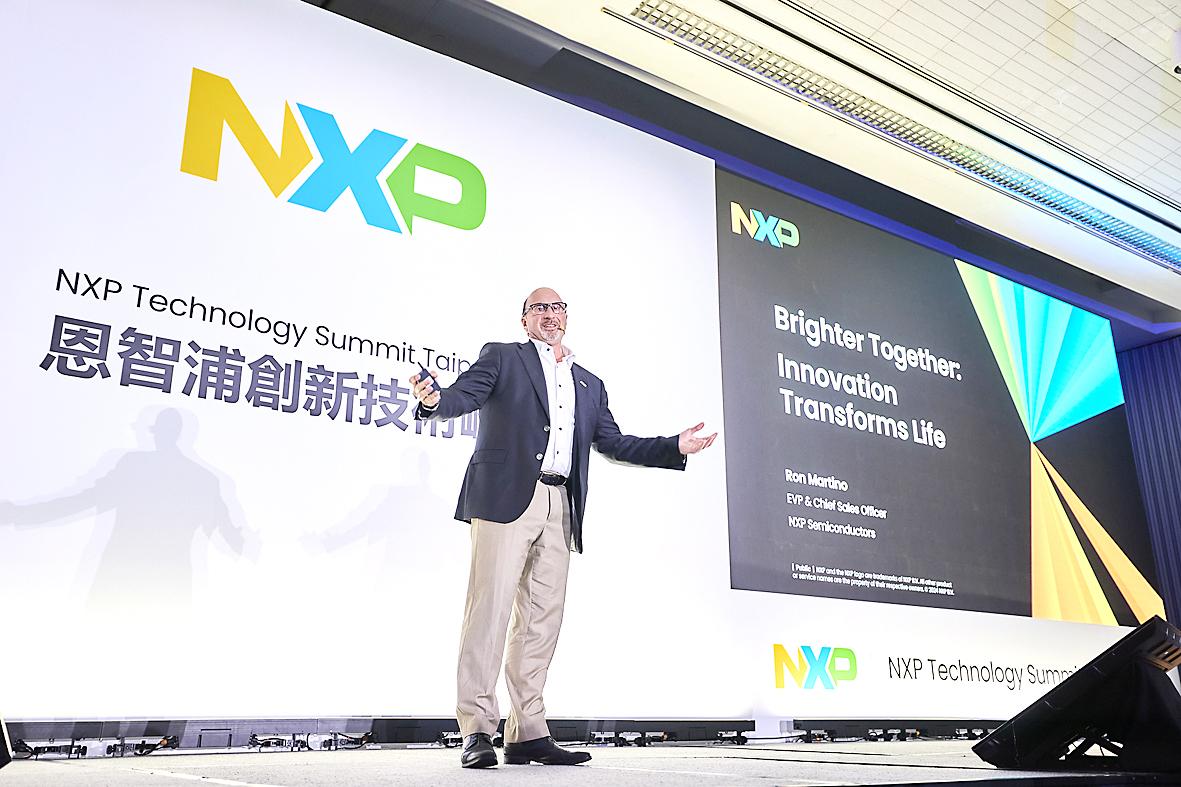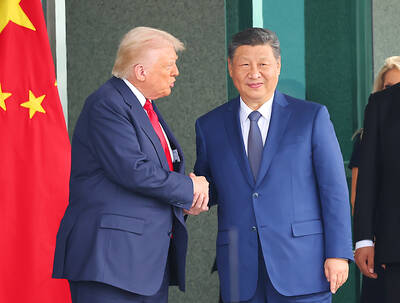The automotive and industrial Internet of Things are two major growth drivers for NXP Semiconductors NV in the next three years, despite the US’ tightening curbs on semiconductor exports to China, the world’s second-largest car chip supplier said yesterday.
The company expects the two segments to see business grow at between 8 and 12 percent from next year to 2027, NXP executive vice president and chief sales officer Ron Martino said at a media briefing in Taipei.
Martino attributed the growth mainly to an increase in semiconductor contents in cars, though the electric vehicle (EV) market is slowing and uncertainty about the world economy abounds, he said.

Photo on courtesy of NXP Semiconductors NV
Asked about what the US’ latest semiconductor export restrictions to China imply for the Dutch company, Martino said that NXP provides services in many countries and regions around the world, and it works to comply with all regulatory requirements placed on the company.
“We have been managing this for many years, very effectively, and we will continue to manage it as different regulatory requirements are applied to NXP,” Martino said.
“We continue to see a very healthy business. We continue to see that we work well together across all regions, with all parties,” he added.
China was the biggest market for NXP last year, representing 33 percent of the company’s total revenue.
The Asia-Pacific market, excluding China, came second with a 28 percent share.
In Taiwan, NXP has formed strong partnerships with Hon Hai Precision Industry Co (鴻海精密) and Foxtron Vehicles Technologies Co (鴻華先進) to introduce at least four EV models in a very short period of time, Martino said.
That is because NXP can bring its new technologies to the market faster in about one to two years, compared with a longer cycle of three to five years, he said.
Aside from Taiwan, such short development cycles only occur in some innovative and disruptive companies in the US or China, he said.
In related news, Hon Hai yesterday reported revenue last month grew 3.47 percent from a year earlier to NT$672.59 billion (US$20.73 billion), benefiting from strong demand for artificial intelligence servers and related components as well as new notebook computers.
“The second half of the year is traditionally the peak season for the information and communication technology industry, so operations are expected to gradually gain momentum quarter by quarter,” Hon Hai said in a statement.
Revenue this quarter is expected to “show significant growth on both a quarterly and yearly basis,” it said.
In the first 11 months, the company accumulated NT$6.21 trillion in revenue, an increase of 8.87 percent from NT$5.7 trillion in the same period last year, Hon Hai said.
Hon Hai, a major assembler of iPhones and AI servers powered by Nvidia Corp's chips, expected revenue this year to grow "significantly" from last year to reach an all-time high.

RUN IT BACK: A succesful first project working with hyperscalers to design chips encouraged MediaTek to start a second project, aiming to hit stride in 2028 MediaTek Inc (聯發科), the world’s biggest smartphone chip supplier, yesterday said it is engaging a second hyperscaler to help design artificial intelligence (AI) accelerators used in data centers following a similar project expected to generate revenue streams soon. The first AI accelerator project is to bring in US$1 billion revenue next year and several billion US dollars more in 2027, MediaTek chief executive officer Rick Tsai (蔡力行) told a virtual investor conference yesterday. The second AI accelerator project is expected to contribute to revenue beginning in 2028, Tsai said. MediaTek yesterday raised its revenue forecast for the global AI accelerator used

TEMPORARY TRUCE: China has made concessions to ease rare earth trade controls, among others, while Washington holds fire on a 100% tariff on all Chinese goods China is effectively suspending implementation of additional export controls on rare earth metals and terminating investigations targeting US companies in the semiconductor supply chain, the White House announced. The White House on Saturday issued a fact sheet outlining some details of the trade pact agreed to earlier in the week by US President Donald Trump and Chinese President Xi Jinping (習近平) that aimed to ease tensions between the world’s two largest economies. Under the deal, China is to issue general licenses valid for exports of rare earths, gallium, germanium, antimony and graphite “for the benefit of US end users and their suppliers

Dutch chipmaker Nexperia BV’s China unit yesterday said that it had established sufficient inventories of finished goods and works-in-progress, and that its supply chain remained secure and stable after its parent halted wafer supplies. The Dutch company suspended supplies of wafers to its Chinese assembly plant a week ago, calling it “a direct consequence of the local management’s recent failure to comply with the agreed contractual payment terms,” Reuters reported on Friday last week. Its China unit called Nexperia’s suspension “unilateral” and “extremely irresponsible,” adding that the Dutch parent’s claim about contractual payment was “misleading and highly deceptive,” according to a statement

Artificial intelligence (AI) giant Nvidia Corp’s most advanced chips would be reserved for US companies and kept out of China and other countries, US President Donald Trump said. During an interview that aired on Sunday on CBS’ 60 Minutes program and in comments to reporters aboard Air Force One, Trump said only US customers should have access to the top-end Blackwell chips offered by Nvidia, the world’s most valuable company by market capitalization. “The most advanced, we will not let anybody have them other than the United States,” he told CBS, echoing remarks made earlier to reporters as he returned to Washington